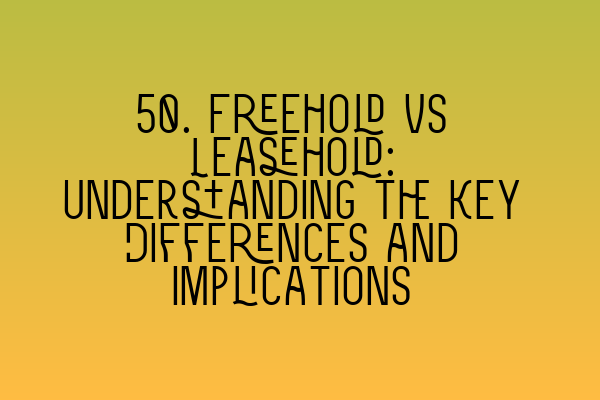As a solicitor specializing in property law, it is important for me to help clients understand the key differences between freehold and leasehold properties and the implications that come with each type. Whether you are planning to buy a property, sell one, or are simply interested in expanding your knowledge, this blog post will provide you with a comprehensive guide to freehold and leasehold properties.
Freehold Properties
A freehold property is a type of ownership where the buyer owns both the property and the land it sits on. This means that the owner has complete control over the property and can make decisions about its use, alterations, and even the duration of ownership.
The key advantage of owning a freehold property is the security it offers. As the sole owner, you have the freedom to do what you please with the property without interference from anyone else. Additionally, freehold properties often appreciate in value over time, making them a valuable long-term investment.
However, with great power comes great responsibility. As the owner, you are solely responsible for the upkeep and maintenance of the property. This includes repairs, insurance, and other associated costs. It is important to consider these factors before purchasing a freehold property.
Here are some key points to remember about freehold properties:
- You own the property and the land it sits on outright.
- You have complete control and decision-making power over the property.
- You are solely responsible for the maintenance and costs associated with the property.
- Freehold properties are often seen as a long-term investment.
Now, let’s move on to leasehold properties.
Leasehold Properties
A leasehold property is a type of ownership where the buyer has a lease agreement with the freeholder or landlord. In this arrangement, the buyer owns the property for a fixed period of time, typically long-term leases can be anywhere from 99 to 999 years, but can also be shorter.
The lease agreement sets out the rights and responsibilities of both the leaseholder and freeholder. While the leaseholder has the right to occupy and use the property, the freeholder retains ownership of the land and has certain rights over the property.
One of the key advantages of leasehold properties is that they often come with added amenities, such as communal gardens, gyms, and parking spaces. These amenities are maintained by the freeholder, saving the leaseholder from the responsibility of their maintenance.
However, leasehold properties also come with certain obligations and potential drawbacks. Leaseholders are typically required to pay ground rent and service charges to the freeholder to cover the cost of maintaining the property and any shared facilities. Leaseholders may also need to seek permission from the freeholder for certain alterations and changes to the property.
Here are some key points to remember about leasehold properties:
- You have ownership of the property for a fixed period of time, as stated in the lease agreement.
- The freeholder retains ownership of the land and has certain rights over the property.
- Leasehold properties often come with added amenities and shared facilities.
- Leaseholders are responsible for paying ground rent and service charges to the freeholder.
Implications and Considerations
When it comes to buying or selling a property, understanding the differences between freehold and leasehold is crucial. Here are some implications and considerations to keep in mind:
- Property Value: Freehold properties typically have higher resale values due to the ownership of both the property and land. Leasehold properties may be subject to restrictions that can impact their marketability.
- Control and Freedom: Freehold properties offer more control and freedom as the owner has the final say in decisions related to the property. Leasehold properties may require permission from the freeholder for alterations or changes.
- Costs and Responsibilities: Freehold properties come with the full responsibility of maintenance costs. Leasehold properties often require payment of ground rent and service charges to cover maintenance costs.
- Length of Ownership: Freehold properties offer indefinite ownership, while leasehold properties have a fixed term stated in the lease agreement.
It is important to carefully consider these implications when deciding between a freehold and a leasehold property. Consulting with a property law solicitor can provide you with expert advice and guidance to make an informed decision.
Conclusion
Understanding the differences between freehold and leasehold properties is essential when navigating the property market. While freehold properties offer complete ownership and control, leasehold properties provide a more communal and shared ownership experience. Each type has its advantages and considerations, and it is important to weigh these factors before making a decision.
At SQE Property Law & Land Law, we specialize in providing expert advice and guidance on all aspects of property law. Our team of experienced solicitors can assist you in understanding and navigating the complexities of freehold and leasehold properties.
Further Readings:
